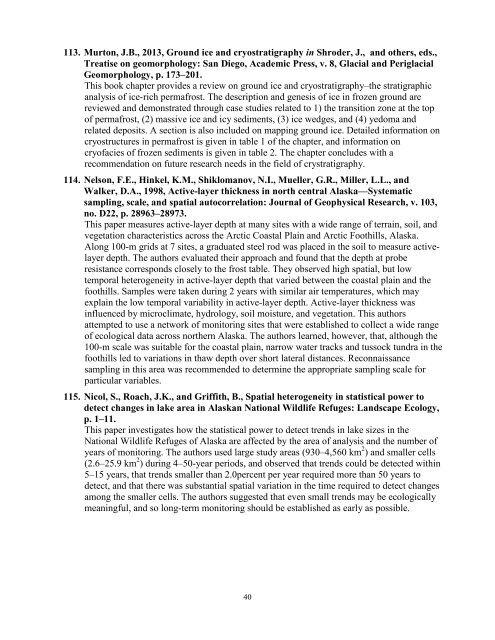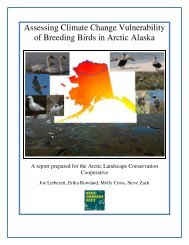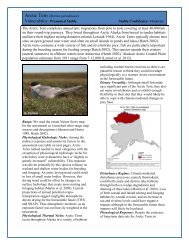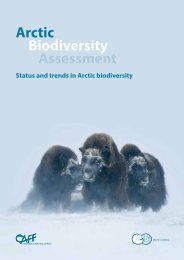Permafrost Terrain Stability and Thermokarst Monitoring: - Arctic LCC
Permafrost Terrain Stability and Thermokarst Monitoring: - Arctic LCC
Permafrost Terrain Stability and Thermokarst Monitoring: - Arctic LCC
Create successful ePaper yourself
Turn your PDF publications into a flip-book with our unique Google optimized e-Paper software.
113. Murton, J.B., 2013, Ground ice <strong>and</strong> cryostratigraphy in Shroder, J., <strong>and</strong> others, eds.,<br />
Treatise on geomorphology: San Diego, Academic Press, v. 8, Glacial <strong>and</strong> Periglacial<br />
Geomorphology, p. 173–201.<br />
This book chapter provides a review on ground ice <strong>and</strong> cryostratigraphy–the stratigraphic<br />
analysis of ice-rich permafrost. The description <strong>and</strong> genesis of ice in frozen ground are<br />
reviewed <strong>and</strong> demonstrated through case studies related to 1) the transition zone at the top<br />
of permafrost, (2) massive ice <strong>and</strong> icy sediments, (3) ice wedges, <strong>and</strong> (4) yedoma <strong>and</strong><br />
related deposits. A section is also included on mapping ground ice. Detailed information on<br />
cryostructures in permafrost is given in table 1 of the chapter, <strong>and</strong> information on<br />
cryofacies of frozen sediments is given in table 2. The chapter concludes with a<br />
recommendation on future research needs in the field of crystratigraphy.<br />
114. Nelson, F.E., Hinkel, K.M., Shiklomanov, N.I., Mueller, G.R., Miller, L.L., <strong>and</strong><br />
Walker, D.A., 1998, Active-layer thickness in north central Alaska—Systematic<br />
sampling, scale, <strong>and</strong> spatial autocorrelation: Journal of Geophysical Research, v. 103,<br />
no. D22, p. 28963–28973.<br />
This paper measures active-layer depth at many sites with a wide range of terrain, soil, <strong>and</strong><br />
vegetation characteristics across the <strong>Arctic</strong> Coastal Plain <strong>and</strong> <strong>Arctic</strong> Foothills, Alaska.<br />
Along 100-m grids at 7 sites, a graduated steel rod was placed in the soil to measure activelayer<br />
depth. The authors evaluated their approach <strong>and</strong> found that the depth at probe<br />
resistance corresponds closely to the frost table. They observed high spatial, but low<br />
temporal heterogeneity in active-layer depth that varied between the coastal plain <strong>and</strong> the<br />
foothills. Samples were taken during 2 years with similar air temperatures, which may<br />
explain the low temporal variability in active-layer depth. Active-layer thickness was<br />
influenced by microclimate, hydrology, soil moisture, <strong>and</strong> vegetation. This authors<br />
attempted to use a network of monitoring sites that were established to collect a wide range<br />
of ecological data across northern Alaska. The authors learned, however, that, although the<br />
100-m scale was suitable for the coastal plain, narrow water tracks <strong>and</strong> tussock tundra in the<br />
foothills led to variations in thaw depth over short lateral distances. Reconnaissance<br />
sampling in this area was recommended to determine the appropriate sampling scale for<br />
particular variables.<br />
115. Nicol, S., Roach, J.K., <strong>and</strong> Griffith, B., Spatial heterogeneity in statistical power to<br />
detect changes in lake area in Alaskan National Wildlife Refuges: L<strong>and</strong>scape Ecology,<br />
p. 1–11.<br />
This paper investigates how the statistical power to detect trends in lake sizes in the<br />
National Wildlife Refuges of Alaska are affected by the area of analysis <strong>and</strong> the number of<br />
years of monitoring. The authors used large study areas (930–4,560 km 2 ) <strong>and</strong> smaller cells<br />
(2.6–25.9 km 2 ) during 4–50-year periods, <strong>and</strong> observed that trends could be detected within<br />
5–15 years, that trends smaller than 2.0percent per year required more than 50 years to<br />
detect, <strong>and</strong> that there was substantial spatial variation in the time required to detect changes<br />
among the smaller cells. The authors suggested that even small trends may be ecologically<br />
meaningful, <strong>and</strong> so long-term monitoring should be established as early as possible.<br />
40








